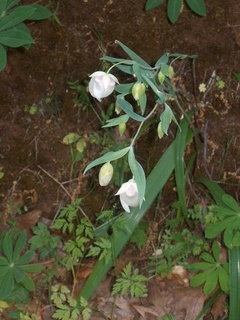Tulips are perennial bulbs in the lily family. Although the genus Tulipa is not native to the Yuba-Sutter area, many close relatives in the genus Calochortus are. The genus Calochortus is divided into several clades, including star tulips (usually found in wet meadows, with erect, pointed petals), mariposa tulips (usually found in dry grasslands, with open wedge-shaped petals and unusual markings on the petals, resembling the markings on the wings of a butterfly), and fairy lanterns (usually found in dense forests, with globe-shaped flowers).
Superb Mariposa Tulip
 Superb mariposa tulip (Calochortus superbus) in a garden in Marysville, with California golden poppies. Photo by queerbychoice. Superb mariposa tulip is a one- to two-foot tall, usually white- but occasionally yellow- or purple-flowering, summer-deciduous mariposa tulip that is native to Yuba County and typically grows at elevations below 5,500 feet. It is found in central oak woodland, valley grassland, or yellow pine forest. It prefers dry sunny areas with good drainage.
Superb mariposa tulip (Calochortus superbus) in a garden in Marysville, with California golden poppies. Photo by queerbychoice. Superb mariposa tulip is a one- to two-foot tall, usually white- but occasionally yellow- or purple-flowering, summer-deciduous mariposa tulip that is native to Yuba County and typically grows at elevations below 5,500 feet. It is found in central oak woodland, valley grassland, or yellow pine forest. It prefers dry sunny areas with good drainage.
You can read more about it at the Theodore Payne Wiki. You can see pictures of it at CalPhotos, Flickr, and Picasa. You can find out where to buy it at the California Native Plant Link Exchange.
White Fairy Lantern
 White fairy lantern (Calochortus albus). Photo by queerbychoice. White fairy lantern is an eight-inch-tall, white- or occasionally pink-flowering, summer-deciduous bulb that is native to Yuba County and typically grows at elevations below 5,000 feet. It is found in central oak woodland or yellow pine forest. It tolerates clay and serpentine. It prefers dry shady areas with good drainage.
White fairy lantern (Calochortus albus). Photo by queerbychoice. White fairy lantern is an eight-inch-tall, white- or occasionally pink-flowering, summer-deciduous bulb that is native to Yuba County and typically grows at elevations below 5,000 feet. It is found in central oak woodland or yellow pine forest. It tolerates clay and serpentine. It prefers dry shady areas with good drainage.
You can read more about it at the Theodore Payne Wiki and the Las Pilitas Nursery website. You can see pictures of it at CalPhotos, Flickr, and Picasa. You can find out where to buy it at the California Native Plant Link Exchange.
Yellow Mariposa Tulip
Yellow mariposa tulip is a one-foot-tall, yellow-flowering, summer-deciduous mariposa tulip that is native to Yuba and Sutter Counties and typically grows at elevations below 2,500 feet. It is found in central oak woodland or valley grassland. It prefers dry sunny areas with good drainage.
You can read more about it at the Theodore Payne Wiki. You can see pictures of it at CalPhotos, Flickr, and Picasa. You can find out where to buy it at the California Native Plant Link Exchange.
Clubhair Mariposa Tulip
Clubhair mariposa tulip is a yellow-flowering mariposa tulip that is native to Yuba County and typically grows at elevations below 6,000 feet. It is found in central oak woodland. It prefers dry sunny areas with good drainage.
You can see pictures of it at CalPhotos, Flickr, and Picasa. You can find out where to buy it at the California Native Plant Link Exchange.
Yellow Star Tulip
Yellow star tulip is a yellow-flowering star tulip that is native to Yuba and Sutter Counties and typically grows at elevations between 1,000 and 3,500 feet. It is most often found on slopes in central oak woodland or yellow pine forest. It prefers dry shady areas with good drainage.
You can see pictures of it at CalPhotos, Flickr, and Picasa. You can find out where to buy it at the California Native Plant Link Exchange.
Blue Star Tulip
Blue star tulip is a blue-flowering star tulip that is native to Yuba County and typically grows at elevations between 3,500 and 7,500 feet. It is found in yellow pine forest. It prefers dry areas with good drainage, and tolerates sun, shade, and serpentine.
You can see pictures of it at CalPhotos, Flickr, and Picasa. You can find out where to buy it at the California Native Plant Link Exchange.
Naked Mariposa Tulip
 Naked mariposa tulip (Calochortus nudus) near Quincy. This flower is named for its relative lack of the hairs at the inner base of the petals that are more numerous in other members of the genus Calochortus. Photo by queerbychoice. Naked mariposa tulip is a pink-flowering mariposa tulip that is native to Yuba County and typically grows at elevations between 4,000 and 7,500 feet. It is most often found in meadows in yellow pine forest or riparian forest. It is equally likely to grow in wetlands or non-wetlands. It prefers moist shady areas and tolerates serpentine.
Naked mariposa tulip (Calochortus nudus) near Quincy. This flower is named for its relative lack of the hairs at the inner base of the petals that are more numerous in other members of the genus Calochortus. Photo by queerbychoice. Naked mariposa tulip is a pink-flowering mariposa tulip that is native to Yuba County and typically grows at elevations between 4,000 and 7,500 feet. It is most often found in meadows in yellow pine forest or riparian forest. It is equally likely to grow in wetlands or non-wetlands. It prefers moist shady areas and tolerates serpentine.
You can see pictures of it at CalPhotos, Flickr, and Picasa. You can find out where to buy it at the California Native Plant Link Exchange.


